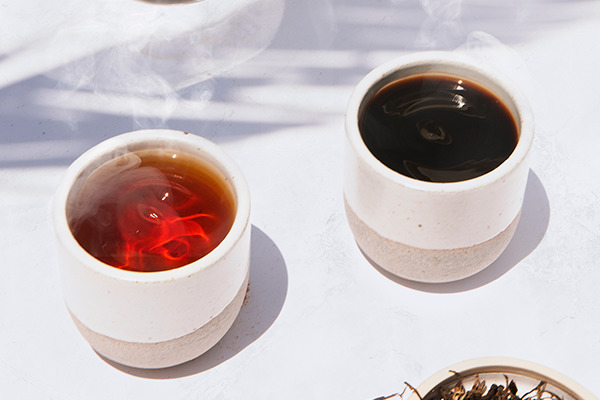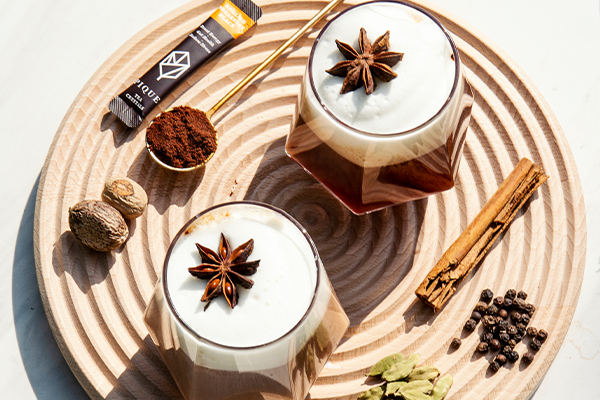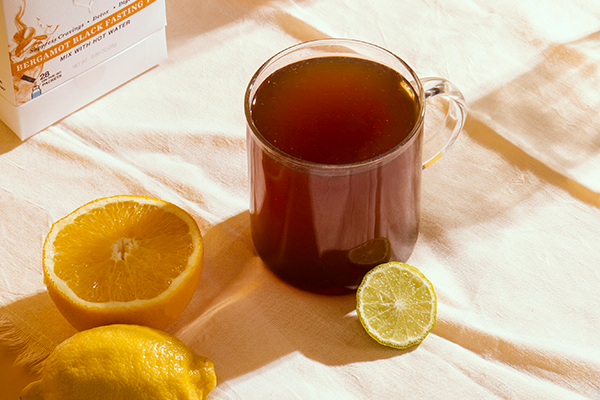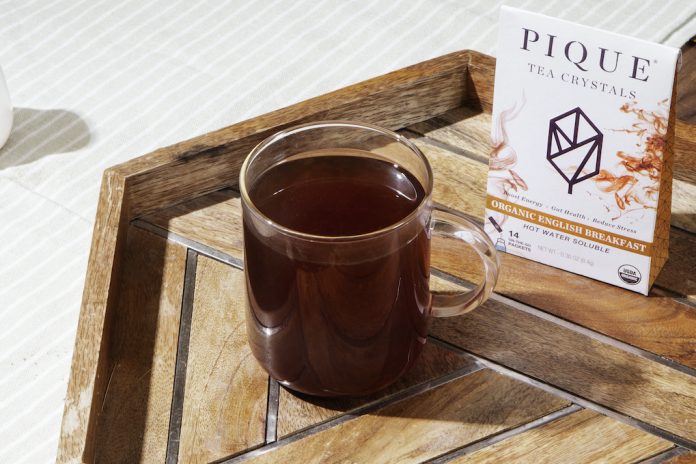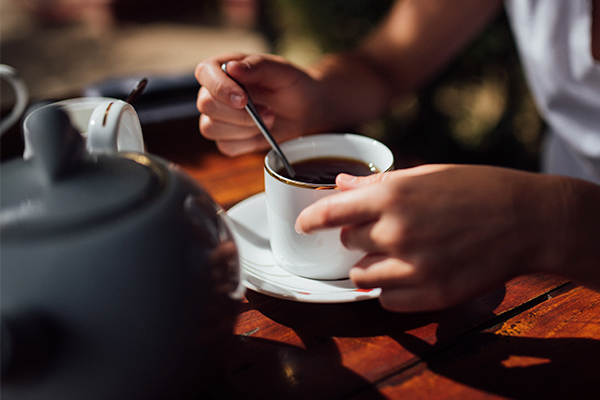If you stop in the tea aisle of your local grocery store, you’re likely to be overwhelmed by the abundance of varieties and flavors. Two of the most popular and well-known options are black tea vs green tea.
Both make decidedly healthy and delicious brews, but the nuances of their flavor, antioxidant profiles, and caffeine content are worth knowing before you drop a box into your cart.
Here are the key similarities and differences between black and green tea, and what makes each of them an excellent choice.
How They’re Made
Black and green tea (as well as white tea and oolong tea) come from the same tea plant: the Camellia sinensis plant. But they are processed differently, and these unique processes are what give each type of tea its characteristic color and flavor.
Once they’re picked, black tea leaves are scrunched and curled to expose as much of the plant to oxygen as possible (aka oxidation). This begins the fermentation process. Black tea can be fermented anywhere from one to four hours. [1]
The longer the fermentation, the darker the color and the deeper the flavor. Black tea generally has a smooth, earthy, smoky flavor, sometimes with hints of caramel or nuts, though the taste will vary slightly from one batch to the next. Every variety of black tea (assam, ceylon, earl grey, english breakfast) is different.
Green tea, on the other hand, is not fermented at all, which is why it retains its green color. Sometimes the leaves are steamed (aka withering) right after picking to enhance the color, but otherwise they are quickly pan-toasted to halt the oxidation process.
Green tea’s flavor is also sharper, somewhat grassy and at times more astringent due to the lack of a fermentation period. This is one reason why green tea is not recommended on an empty stomach – especially if you have a sensitive tummy.
Like black tea, there are several varieties of green tea and each has a unique flavor profile.
Health Benefits of Black Tea
The fermentation process also influences the types and amounts of antioxidants present in black and green tea.
Tea can be considered a functional food because of its high concentration of antioxidants. A functional food provides health benefits beyond the components of basic nutrition (2). Tea has no calories, protein or fat, and no significant amount of vitamins or minerals.
But its antioxidants confer a host of health benefits not quantified on a nutrition label.
According to one peer-reviewed research article: “Black tea leaves are reported to contain thousands of bioactive constituents such as polyphenols, l-theanine, amino acids, volatile compounds, and flavonoids that exhibit a range of promising pharmacological properties.” (3)
Every fresh tea leaf is rich with a certain type of antioxidant called catechins — in particular, epigallocatechin gallate (EGCG) (4). If you’ve ever come across an article touting the health benefits of green tea, you likely noticed that these catechins are what gives a cup of green tea its claim to health fame.
During fermentation, however (i.e. turning green tea into black tea) these catechins undergo chemical reactions with oxygen that convert them to another type of antioxidant called theaflavins and thearubigins.
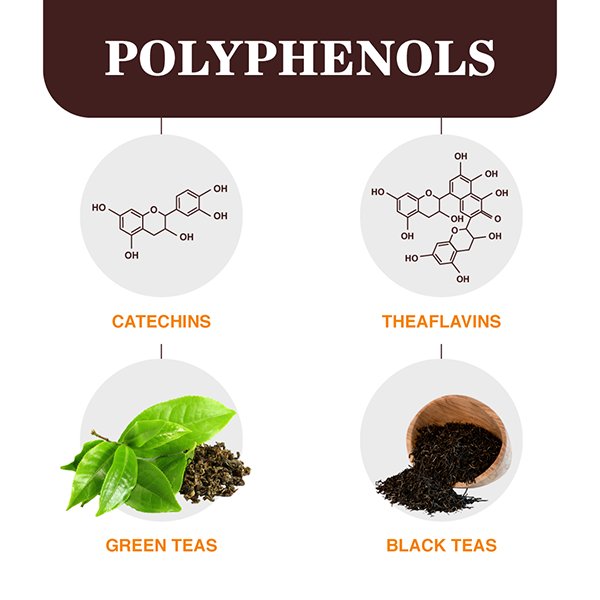
These compounds formed during fermentation are responsible for the color, taste, flavor, and aroma of black tea. (1). They also have their own set of unique potential health benefits. Green tea is more often spotlighted as the antioxidant superstar, but black tea deserves some attention as well.
One study found that theaflavins and thearubigins supported cellular health. Another found that theaflavins helped to support healthy cholesterol levels. (5)
It should be noted that neither of these studies was done with human subjects.
Nonetheless, the results suggest that the antioxidant compounds found in tea could have similar supportive benefits for humans as well.
Health Benefits of Green Tea
The catechins found in green tea are no different. Though they have a different structure, they provide many similar health benefits as theaflavins. [6]
Green tea generally has a higher concentration of antioxidants overall because it undergoes less processing, meaning there are fewer opportunities for catechins to be degraded or destroyed. [7]
By binding with free radicals — the byproducts generated by the oxidative processes that damage cells and their DNA — catechins help to mitigate further damage. This is why green tea consumption is often linked to supporting cellular health, as well as supporting a healthy immune system. [8]
The takeaway? Though black and green teas contain different profiles of antioxidant compounds, they both may help to support vibrant health. If you’re choosing tea based on health benefits alone, both varieties will fit the bill.
(Curious about green tea extract and whether its weight loss reputation is backed by science? Check out this article.)
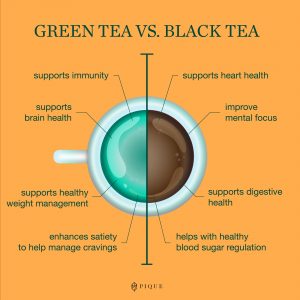
Tea as a Weight Management Tool
Some research has found that both black and green tea can be helpful in supporting healthy weight management and that the polyphenols in black tea may even be more potent than green tea when it comes to those efforts. (11)
Some compounds in black tea may interfere with the digestion and absorption of calories from fat and carbs, and possibly support the breakdown of existing stores of body fat. Green tea polyphenols have likewise been shown to support healthy metabolism. (12)
Caffeine Content
Health may not be the only priority guiding your decision. Most of us are also looking for a little jolt of energy from our mugs.
The U.S. is predominantly a coffee-drinking country. In 2018, 64% of American adults reported having at least one daily cup of joe. (13)
Tea is not as integral to our culture as it is in China and Japan where tea originated and is consumed for social, ceremonial and medicinal purposes as often as it’s consumed for its taste.
We are a nation that needs its caffeine — which may explain why 84% of the tea consumed in this country is black tea. (14)
Black tea delivers the highest amount of caffeine of all tea varieties at an average of 47 mg per cup. For reference, a cup of regular coffee contains about 137 mg per cup. Green tea — typically no more than 30 mg per cup. (15)
Black tea, then, is a great option at breakfast, especially if you’re trying to consume less caffeine or break a coffee addiction. Green tea may be better as an early afternoon pick-me-up.
Brewing Guide
Tea lovers know that even the best teas can be ruined by the wrong brewing techniques.
With black tea, there’s more room for error. Because they’ve already been oxidized, fermented and sometimes roasted, the leaves can stand up to hotter water and longer brewing times. The flavor gets stronger and sometimes slightly bitter the longer the tea bag steeps — it really depends on personal preference.
More delicate green tea leaves generally need a gentler approach. Use hot water (not boiling water) on your loose leaf tea — between 145 and 180 degrees Fahrenheit is ideal — and steep for up to three minutes.
Final Thoughts
Tea drinkers unite! Both black and green types of tea are flavorful and healthful. No matter which is in your cup every day, when you’re drinking tea, you should take the time to savor each sip and note their unique tastes and aromas. Be sure to try different varieties and find your favorite!
